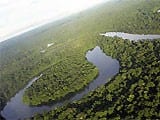 Souza Jr, C., Cochrane, M., Sales, M., Monteiro, A. L., & Mollicone, D. 2009. Integrating Forest Transects and Remote Sensing data to Quantify Carbon Loss due to Forest Degradation: a case study of the Brazilian Amazon. Forest Resources Assessment Working Paper 161: Case studies on measuring and assessing forest degradation (p. 23). Roma: FAO.
Souza Jr, C., Cochrane, M., Sales, M., Monteiro, A. L., & Mollicone, D. 2009. Integrating Forest Transects and Remote Sensing data to Quantify Carbon Loss due to Forest Degradation: a case study of the Brazilian Amazon. Forest Resources Assessment Working Paper 161: Case studies on measuring and assessing forest degradation (p. 23). Roma: FAO.
Characterizing and quantifying carbon stocks due to forest degradation is one of the greatest challenges to advancing in climate change negotiation on carbon payments through the Reducing Emissions from Deforestation and Degradation (REDD) proposal. Defining forest degradation, in this context is fundamental, since this process can mean many things to different stakeholders. For the purpose of climate change negotiation, forest degradation must be defined in terms of loss of carbon stocks, even though there are other forest ecological and biophysical processes that can be degraded, such as biodiversity content, soil erosion and compaction, tree species extinction and changes in the forest microclimate and albedo. In the Brazilian Amazon, forest degradation is mainly caused by selective logging, fires and forest fragmentation. These degradation processes operate synergistically and recurrently, which can lead to even more drastic loss of original carbon stocks from the original forest. In the past ten years, ur research team has been involved in projects to characterize forest degradation through forest inventories and remote sensing analysis. We have developed a methodology for assessing forest degradation based on field transects that allows us to estimate the intensity of forest degradation based on the loss of forest biomass stocks, forest canopy damage and soil disturbance, and as well as carbon sequestration due to regeneration of degraded forests. Additionally, we have developed a remote sensing methodology to detect and map the extent of forest degradation based on canopy damage and small clearings created by logging infrastructure, such as roads and log landings. These field and remote sensing methods have been applied extensively throughout the Brazilian Amazon, covering different logging, forest fragmentation and fire intensities. In this case study, we demonstrate how these methods have been applied and show new results of our recent efforts to integrate field and remote sensing data to improve the characterization and quantification of net carbon stocks associated with forest degradation in the Brazilian Amazon. Our results hold promise for contributing towards REDD negotiation, given that they can provide accurate estimations of carbon stock changes due to forest degradation and reliable information for defining baselines, as well as improving monitoring, reporting and verification (MRV) of REDD projects.
